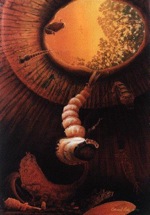
by Matthew Chmielewski, Biology graduate student, Clark University
Photos courtesy of U.S. Centers for Disease Control and Prevention
Illustrations courtesy of the American Mosquito Control Association.
Mosquitoes have been a problem for people all over the world as long as humans have existed. This stems partly from the fact that the 3000 or so known species of mosquitoes have found places to live and roles to fill in almost every climate and ecosystem available. They have evolved many tricks over thousands of years to make them very good at what they do. These tricks include specialized mouthparts for blood feeding, incredible sensory perception, and most amazingly, the development from an aquatic life stage through to an airborne home.
LIFE STAGES:
A mosquito's life can be divided typically into 4 major life stages. These are the egg, the larva (plural= larvae), the pupa (plural= pupae), and the adult. Each of these stages has a body that is specially designed for the type of activities it will be doing. The ability for the mosquito to go from one to the other is an amazing transformation, comparably complicated to metamorphosis in butterflies. We will look at all the stages in depth, one by one to complete the life cycle of the typical mosquito.
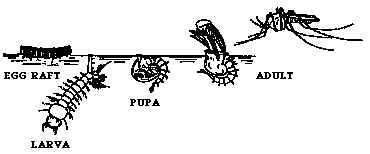
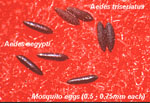 1: Egg Mosquito eggs are very small
due to the small nature of the mosquito itself. Most
people have never looked hard enough to find
mosquito eggs to see what they look like. The eggs
of a mosquito are usually narrow and thin, much
longer than they are wide. They can be found in all
sorts of water habitats, including rivers, rock
holes, tires, swamps, lakes, coffee cups, pineapple
tops, treeholes (like our experimental mosquito),
snail shells, and even the tops of some
mushrooms.
1: Egg Mosquito eggs are very small
due to the small nature of the mosquito itself. Most
people have never looked hard enough to find
mosquito eggs to see what they look like. The eggs
of a mosquito are usually narrow and thin, much
longer than they are wide. They can be found in all
sorts of water habitats, including rivers, rock
holes, tires, swamps, lakes, coffee cups, pineapple
tops, treeholes (like our experimental mosquito),
snail shells, and even the tops of some
mushrooms.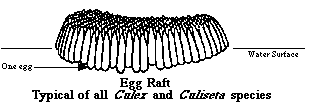
Many species will lay their eggs on top of the water,
either singly or in little raft shapes. The eggs and rafts
can be shaped differently depending on the species of
mosquito involved. Those laid singly are many times shaped
like a small canoe, with rounded up ends and floats on the
sides, to keep the egg on the surface. Those laid in rafts
lie vertically and stick together due to surface
attraction. The raft altogether becomes shaped like a wedge
with upturned ends, like a canoe.
Other species,
like the treehole breeder that the Labor Day Mosquito Count
is focusing on, lay their eggs along the edges of water on
the walls of the container. The eggs, which can endure dry
conditions, can then sit around until rain fills the
container more and they are submerged. At this point the
eggs are in the water and they can
hatch.
Eggs
have been known to stand up to many harsh situations and
survive through them. Some mosquito eggs are laid by adults
that live in desert areas and can survive for months
without any water. When the rain does come they are quick
to hatch and grow up before the water pools formed in the
wet season dry up again. Other eggs can withstand being
frozen in cold and temperate lands. These eggs hatch when
the weather becomes warm again in the late
spring.
To prevent all the larvae from dying if
something should happen to a pool of water, some eggs are
laid in such a way that they are spread out. That way there
is a better chance of some of each group of eggs surviving.
This also makes it so that the larvae aren't forced into
competing with their siblings. Some eggs that are laid in
groups get around this problem by hatching at different
times. If many eggs have already hatched, the remaining
ones will wait until those larvae are gone until they begin
to hatch again. Some of the work done in this lab has shown
that the larvae must touch the eggs in order to prevent
hatching, and that the eggs don't hatch when the larvae
have removed bacteria from the eggs'
shells.
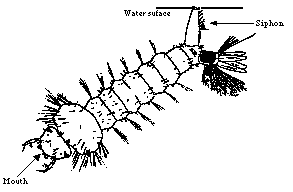
2:
LarvaLarvae are
the most active aquatic form of the mosquito. They are
a large part of the life cycle of the mosquito, and
therefore are well adapted to their role. Since the
adults can no longer grow, success as a larva will
determine how large the adults can be. Adult size
limits how many eggs can be produced, so things that
change larval success will affect the birth rate in
the next generation. This stage can be considered just
as important, in a way, as the adult stage. While this
is true, to humans, the adult is the worrisome stage
and the larvae are many times
overlooked.
Mosquito larvae are little long and
hairy wormlike creatures. They of course don't have
hair as monkeys, dogs, and humans do (all over our
bodies), but instead have a more limited amount of
spines that stick out all over the place. These tiny
spines help the larvae feel around them and also to
float in the water.
The ability to float is important
because mosquito larvae need air just as we do. They
have developed a specialized structure called a
breathing siphon. This is kind of like a long straw
sticking out of the mosquito that goes up to the
surface of the water and breathes the air that is up
there. Some mosquitoes have long breathing siphons,
and others have shorter ones. Those with longer ones
usually feed deeper in the water, while those with
shorter siphons feed mainly at the
surface.
Mosquito larvae are usually
filter-feeders. They have fan-like mouth brushes that
sweep water at their mouths from in front of them. In
this method they filter out small particles of
decaying material and microorganisms, which they then
eat. Some larger larvae are known to eat other
mosquito larvae. These larvae get lots of protein by
eating other species, and even members of their own
species. As these do not bite people when they turn
into adults, and they control populations of biting
mosquitoes, the predatory larvae have been called allies to humans in
the fight against mosquitoes.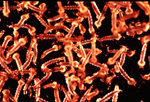
Larvae swim by wiggling their bodies
back and forth. They do so to move up and down the
water column to feed, and to avoid danger. When
mosquito larvae sense a sudden change in light
intensity they immediately swim towards the bottom of
the water container they are in to avoid being eaten
from up above. It is very easy to observe this when
approaching any container containing larvae
within.
Some larvae have a specialized
breathing siphon that allows them to pierce the roots
and stems of water plants to get air. These larvae use
little saw-like structures to get at air pockets
within the plants. They can then hook onto the plant
to eat and breathe while totally submerged under the
water.
The larva of a mosquito goes through
four stages called instars. These are successively
bigger stages that lead towards the pupa stage from
the egg. These four instars are each categorized by
the growth developments going on within the larvae
that are progressing toward the adult stage. Each
stage sets up more and more pockets of cells that will
later grow and change to become parts of the adult
body.
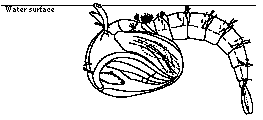
3:
PupaAt the end of
the fourth larval instar, the skin of the larva splits
and the pupa comes out. It is shaped like a comma, has
no mouth, and swims by a sort of kicking motion unlike
the wriggling of the larva. It has two trumpet shaped
breathing tubes on the top of its head rather than the
one on its rear as in the larval stage. Like larvae,
the pupae are also sensitive to light changes,
swimming to the bottom if anything moves over the
water.
If pupae become stranded due to the
drying out of their water pool, they are still able to
turn into mosquitoes, if they are not first eaten or
exposed to too dry of conditions. They can also kick
and bounce around until they come to a new pool of
water, if there is one nearby.
If the conditions are right, it only
takes a few days for the pupa to transform into an
adult. The insides of the pupa change while it rests
on the surface, parts breaking down while new parts
form. After the change fully takes place, the adult is
ready to break free. During the last few minutes the
pupa loses the ability to swim around and can only
float on the surface. Soon after the top part of the
pupa splits open and the adult mosquito squeezes out
of the pupal skin. It is able to do so because it is
still soft and will harden within the next hour. The
adult climbs out of the pupa and stands on the
surface. In a few minutes it is able to make its first
flight to a nearby tree or wall to rest while it
finishes developing.
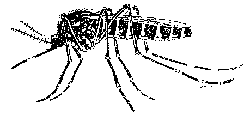
4:
AdultThe adult
mosquito is the form that most people fear. It is the
form that makes those itchy bumps we get. It is the
form that can spread disease. While the other forms
are not very well known, the adult mosquito is a
creature that is known to almost everyone in the
entire world. It does, however have a range of
activity that is probably not known to most
people.
One of the first important things to
cover is that only the females feed off of blood. The
females use the blood to nourish and develop eggs.
Otherwise both males and females feed on honey-dew,
nectar from flowers, and juice from berries and fruit.
It is important to note again that those mosquitoes
that eat other larvae in their larval stage tend to
not need any blood-meal to nourish eggs. These eating
habits are a bit elusive, as nectar feeding usually
happens early mornings and late evenings. In the lab,
it is easy to show this need for a carbohydrate source
by providing caged adults with a flask of sugar-water
solution, made available to them with a paper towel or
cotton wick, and depriving another group of the same.
They need a carbohydrate meal every couple of days to
survive.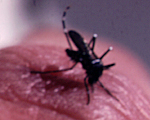
To find a blood meal, however, is
vital if a female is to lay eggs. Some females can get
by without a blood meal for their first batch of eggs,
even if they weren't predators in their larval stages,
but to most it is essential. They have many biological
"tricks" they employ when approaching their intended
victim.
The most obvious one, of course, is
vision, but this tends to be limited to short range
location at best. Many mosquitoes approach their
blood-hosts at night, so vision may be even less
helpful then. The second trick is heat sense. Using
the many receptors they have on their antennae, the
mosquitoes are attracted to heat, which allows them to
follow the movement trails of animals upwind of them.
The mosquitoes turn and follow the warm air to their
target. This is combined with smell also via the
antennae receptors. The combination allows them to
follow the warm, moist trail filled with scent that we
leave behind as we move. Mosquitoes are attracted to
carbon dioxide, as well as other chemicals such as
lactic acid. If we are physically exercising, this can
increase the chance of mosquitoes finding us. Lastly,
mosquitoes can use sound vibrations as locators, but
this really becomes most important for
males.
For females to lay eggs, there needs
to be both a male and a female. The female needs a
blood meal, and the male needs to give his DNA to the
female. The males find females using sound. Their
antennae are all bristly with little hairs that act to
receive sound. When a female flies by, they can hear
her and locate exactly where she is by her sound. Once
they meet each other the female can take the male's
DNA and go lay her eggs. Quite often, she will already
have some ready for laying before mating, but she can
store sperm for fertilizing her eggs later. Sometimes
the males will hang around in a large group, often
times noticeable on late summer afternoons. These
males dance around in a group getting all excited
about meeting the females and then grab any that go
by. It's sort of like a dance club where males all go
to dance and get energized to go dating the female
mosquitoes.
After the female has met the male
and gotten the blood she needs, her eggs finish
developing. She finds an appropriate spot on the edge
of the water, in the water, or where water will be
when it rains (in a very dry situation), depending on
the species of mosquito. She adds the male DNA to each
egg as she lays them. Once she finishes with this, she
flies off and tries to store up some more energy, get
another blood meal, and do the egg laying process over
again. The second time she doesn't need any more
males, she is set essentially for her life after the
first time. The egg, on the other hand, begins the
whole journey through all the life cycles, repeating
the same processes that the mother just had to go
through.


